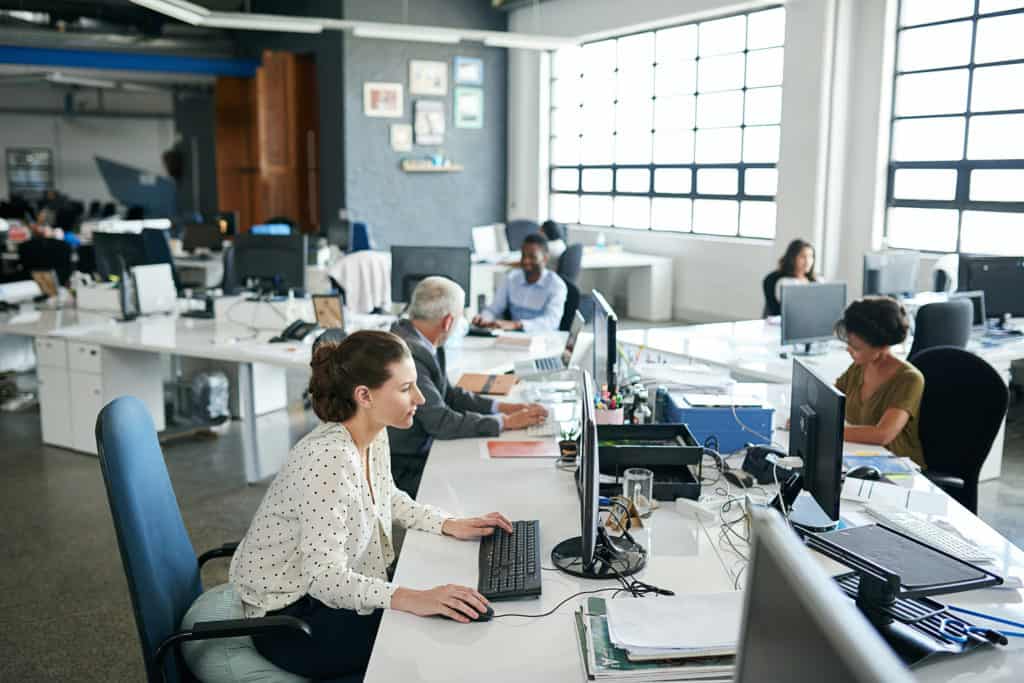When a company outgrows its workspace, people usually jump to the most logical answer: Add more space.
When the firm where I work outgrew its space, we challenged the logic. Rather than adding more space, we asked: Could we add more people and increase employee collaboration, engagement and innovation all while maintaining current square footage?
Our answer turned into a living lab of different workstations, focus rooms and a work café housing a combination of dedicated workspaces as well as flexible work areas for ‘Flexers,’ staff that do not have assigned workspace. Here’s what we discovered.
1. Once people realize they don’t need paper, they are fine with less space
When we looked at staff’s desks, only a small portion was used for actual working desk space. The rest was a combination of project piles and personal items.
With dual, large-scale monitors, employees can easily view multiple digital documents, reducing the need for printing. Shared layout areas provide worktops for document reviews or for quick standing meetings while a focus room accommodates tasks needing more space. Armed with options, people found their new six-foot desk with side storage unit works well.
2. Our new open workspace is the quietest spot in our office
No longer hidden behind workstation panels that give people a false sense that no one can hear them talking, staff are now aware of others around them and have adjusted to a quieter voice level. Conversations still occur, but they are shorter (which helps with productivity). Longer conversations move to nearby conference spaces.
3. Introverts love the open environment
Shy or introverted employees can find fitting into a new company’s culture challenging. The open environment offers an opportunity to see and interact with coworkers with minimal effort.
One of our more introverted employees admitted she felt more connected with her coworkers after moving to a work area where everyone could see one another and participate in casual conversation without physically joining a group. She couldn’t help but to get to know coworkers around her, and as a result felt a greater sense of belonging.
4. Some people need more space…and it’s not always who you’d think
It may be no surprise that recent graduates work well at smaller stations or as flexers since they have not accumulated “stuff.” However, senior-level positions also have less physical paper, use more digital processes, and, therefore, are more easily be accommodated by smaller work stations.
It is the mid-level employee that we found to be keepers of project documents and required a more storage. By reviewing work processes, space can be allocated appropriately to ensure that workers have the tools they need to do the most useful activities.
5. Extroverts need quiet spaces, too
In today’s high-stimulation environments, it’s easy to feel overloaded. Our one-person focus rooms are used equally by introverts and extroverts, for personal phone calls, lengthy tele/or virtual conferencing, or just a quiet space to work.
We are seeing more and more studies of how stress drains people’s productivity, engagement and wellbeing. Providing quiet areas for staff to regenerate is essential in today’s workplace.
6. The process of getting rid of personal items at employees’ desks can be emotional
When one employee decided to go “flex,” he was surprised at how attached he had become to the knickknacks he had accumulated — kids’ drawings, humorous gifts from coworkers, even his favorite coffee mug. Remember to allow space for personal items, such as a locker, even for flex workers.
7. The mobile, flex environment allows us to be strategic about who we sit next to
“Every morning as I walk into the office I think, ‘What am I working on today and who should I sit by?’”
“Every time I finish a task, I reward myself by moving to another location in the office. It allows me to clear my mind and focus on a new task.”
Giving employees control over their location allows them to determine how they work best and gives them control over their professional development. If they want to learn something new, or get to know someone better, they can sit by who they want, including the CFO or CEO. That accessibility is what many younger generations are looking for in a company.
8. Mentoring often comes from unexpected places
In an office where staff move around frequently, I’ve sat next to 100 different people over 20 years at our firm. The benefit has been the mentoring I’ve received on all aspects of our business and to know more coworkers better. Our flex environment is creating more of these opportunities for all staff, making more knowledgeable employees, better team members and strengthening connections to the company.
9. Windows are for everyone
In most organizations, hierarchy determines proximity to natural daylight (corner office, anyone?) While our traditional office design is an open office with views for everyone, the most senior staff still sat closest to the windows. In our new office space, the workspace closest to the windows are unassigned and free for everyone to drop-in and use.
10. You don’t know how far you can go until you try
Surveys, observations, benchmarking and research informed our design, but testing proved what would really work for our organization. Testing five different workstations for both functionality and preference helped us discover the six-foot desk works well (surprise), staff really loved the sit-to-stand option (not surprised), and one file drawer and small bookshelf was all that was needed for resident workers.
For the flexers, we provided tall lockers, but learned after a few months that people discovered they only needed half that storage. We also learned that the tablet-arm lounge chairs don’t get as much use, and everyone loves the focus rooms and work café. This valuable information allows us to plan our future renovations and allows our employees to do the best work they can.

